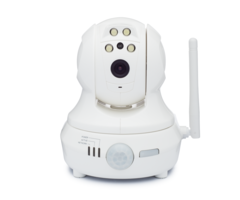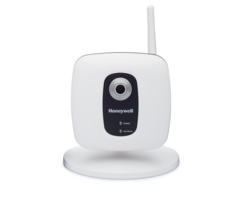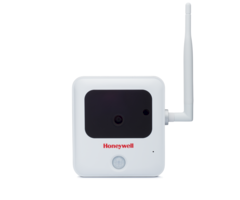Honeywell IP Cam PT Quick Install Guide
Related Products



Related Categories
Document Transcript
iPCAM-PT Pan and Tilt Wireless Internet Video Camera – Quick Installation Guide
For Online Support visit: http://www.security.honeywell.com/hsc/resources/MyWebTech/
General Information
This guide provides information on installing and setting up Honeywell's iPCAM-PT Camera. This camera is ideal for monitoring your home, business or public facilities. Some major features of this camera are: Wired or Wireless communications to a router or access point. Wireless communications utilizes the 802.11g protocol with WPS security. WPS (Wi-Fi Protected Setup) is a standard for easy setup of a secure wireless network. Pan and Tilt Color video can be controlled and monitored through your Total Connect remote services account. Up to 6 cameras can be used. Auxiliary LED lighting that improves the quality of video up to 15 feet in low-level light situations. IMPORTANT: This camera is for indoor use only. To avoid damage to the drive mechanism, do not manually pan or tilt the camera. DO NOT mount this camera within one [1] foot of any wireless device. To utilize this camera, you must have: Security system with a GSM, i-GSM or internet communications device. Total Connect account. (If an account does not exist, the dealer should use the AlarmNet Direct website to setup a Total Connect account for the customer.) Internet access with a router capable of DHCP hosting. For wireless, the router must also support one button WPS data encryption. If this is not available, order the Honeywell WAP Wireless Access Point for connection to your router. PACKAGE CONTENTS
Mounting Plate
Power Transformer
Camera GPIO Connector (Future use.)
Component Identification
Power (green) Blinking – Camera initialization period, may take up to 20 seconds. Steady On – Camera is initialized and power is on. Active (green) Off – No user is viewing the camera. Blinking – User(s) are viewing this camera. Network (green/amber) Solid green – Wireless / LAN is available. Blinking green – Normal transfers. Blinking amber (during WPS setup only) – WPS is normal. Steady amber – If greater than 5 sec. there is a WPS fault. Off – Wireless / LAN not connected. LED Lights – May be manually activated.
POWER RESET WPS LAN
GND DO GND DI
SPKR OUT
Lens – Fixed lens requires no focusing. Clean with a soft tissue and lens cleaner.
Microphone – Not used.
POWER ACTIVE NETWORK
DO NOT USE THIS BUTTON NOTE: Ensure the green light is OFF. If the green light is on: If logged into Total Connect, log out. Click the button once to turn it off. You may log back into Total Connect.
Motion Sensor – Future use.
Power Connector – Connect transformer here. Reset Button – Resets IP Camera to default settings. (Use a paper clip to depress and hold for 12 seconds, then RELEASE.) Upon a successful reset, the Power, Active, and Network LEDs blink 3 times. WPS Button – Used during setup to configure wireless encrypted connectivity. LAN Connector – Used for wired connectivity. When used the wireless is disabled. The camera must be powered off whenever connecting or disconnecting the Ethernet cable. GPIO Connector Socket – Future use. Speaker Out – Not used.
1. Mount the Camera
On horizontal mounting surfaces, such as a shelf, the mounting plate is typically not necessary. However if there is vibration, or the mounting surface is very small you may choose to use the mounting plate. This will ensure the camera does not move from vibration or if the wires are tugged. 1. If mounting the camera to a vertical or overhead surface, use the Mounting Plate. Use all three holes in the Mounting Plate along with screws that are suitable for the mounting surface (do not use flat head screws). 2. Slide the camera onto the Mounting Plate until fully seated as indicated by a clicking sound. 3. Orient the antenna vertically. 4. Connect the Power Transformer wire to the Power Connector on the camera back. At this time DO NOT plug the power transformer in. IMPORTANT: In order for the camera to be placed in the wired mode, the Ethernet cable must be connected first, then power applied. Likewise in order for the camera to be placed in the wireless mode, ensure the Ethernet cable is NOT connected, then apply power. Follow the directions on the right carefully for applying power. NOTE: The Power Transformer must be powered by a non-switchable power outlet. 5. Refer to the diagram below, and determine which configuration applies.
2. Power and Configure Wireless Security
If you have Configuration #1 – Connect each camera to the router using an Ethernet cable. Then plug the Power Transformer into an outlet. The camera installation is DONE. If you have Configuration #2 – Complete all the steps below. If you have Configuration #3 – You must attach the optional Honeywell WAP Wireless Access Point to the router, then complete all the steps below. NOTES: When setting up a wireless configuration in very large buildings or buildings with dense walls, wireless communications may be marginal. It is best to first configure the system in the same room. Then upon successful configuration, place each camera in the desired location. Check to see that all cameras exhibit good communications as indicated by a STEADY GREEN Power LED and a Network LED that occasionally BLINKS GREEN. If using more than one wireless camera, each must be configured for wireless security. If using a router instead of Honeywell's WAP, please ensure your router is configured for DHCP. (This is the default setting for most routers.) If you are unsure, you can access the router's configuration page and set it for DHCP (refer to the router's manual). Since the operation of each router varies, please refer to the router's manufacturer for support. Configuring Wireless Security: When initially powered up, the camera and WAP use the same default AES key and encryption parameters. To create a new AES key, please perform the steps below. 1. Ensure an Ethernet cable is not connected to the camera, then plug the Power Transformer into an outlet. Wait for the Power indicator to light solid. 2. Press and hold the WPS button on the router, or WAP Wireless Access Point, for 3 seconds, then RELEASE. 3. Within 1 minute, click and RELEASE the WPS button on the camera. 4. Allow up to 45 seconds for the WPS to complete, then verify successful wireless security as indicated by a STEADY GREEN Power LED and a Network LED that occasionally BLINKS GREEN. If these indicators are present you are done. 5. Repeat the steps above for each camera. Wireless Security Indications LED Indicators Network – BLINKING AMBER Comment / Action Camera is searching for and trying to process a WPS signal from a router or access point. Try the following: 1. Wait for the Network LED to turn STEADY AMBER. 2. On the router or wireless access point, press and hold the WPS button for 3 seconds, then RELEASE. Allow up to 45 seconds for the WPS to complete, then verify successful wireless security as indicated by a STEADY GREEN Power LED and a Network LED that occasionally BLINKS GREEN. If greater than 5 seconds, the WPS configuration was unsuccessful. Repeat steps 1 thru 4 above.
Network – STEADY AMBER
NOTE: If the camera is being used in a wireless mode and the Reset button on the back of the camera is used, you must reconfigure wireless security for that camera.
3. Add or Edit the Camera(s) in AlarmNet Direct
You will need the following information: AlarmNet Direct account with user name and password. Account number and MAC ID for the GSM, iGSM or internet communications device. MAC ID for each camera. The MAC ID is on the box. NOTE: If you are installing multiple cameras and they get separated from their boxes, the last 6 digits of the MAC ID is also on the bottom of the camera (Server Name). 1. Log into AlarmNet Direct. https://services.alarmnet.com/AlarmNetDirect/
The last 6 digits of the MAC ID is also on the bottom of the camera.
2. Click Show Programmed Devices GSM/I.
6. From this screen you can add a camera by entering the VIDEO MAC ID (located on the box and on the back of the camera).
3. Search for the communications device by entering the customer Account # or the MAC ID of the communications device. Then click Search.
7. In the Video Device Name field, enter a friendly name for the camera such as; kitchen, porch, garage, etc. 8. Click Add Video Device. NOTE: You can also edit an existing camera by clicking Edit/Delete in the Action column. This will allow you to change the Video Device Name, or simply delete that camera. 9. Save and close, then log out of AlarmNet Direct. 4. Ensure the account is active and enabled for Remote Services. This can be determined by looking at the status icons.
The cameras are now ready for customer use. Have the customer log into their Total Connect account to view the video. If their PC does not have QuickTime® and Flash® Player, you will be prompted to install or update these applications. If any of the cameras were mounted upside down, there is a setting to upright the image. At this time the location of each camera can be adjusted for the desired view. NOTE: When adding, editing, or deleting a camera, the customer will receive email notification.
Must have.
Account must be registered.
NOTE: If the account is not properly configured, refer to the online help and configure the account. 5. In the Actions column, use the drop-down menu to select Video-Configure. Then click GO.
TRADEMARKS Honeywell is a registered trademark of Honeywell International Inc. Flash is a registered trademark of Adobe Systems Incorporated, registered in the U.S. and other countries. QuickTime is a registered trademark of Apple Inc., registered in the U.S. and other countries.
Ê800-05307V1-Š
800-05307V1 5/10 Rev. A
2 Corporate Center Drive, Suite 100 P.O. Box 9040, Melville, NY 11747 Copyright 2009 Honeywell International Inc. www.honeywell.com/security
WARRANTY For the latest warranty information go to: http://www.security.honeywell.com/hsc/resources/wa/
- Uploaded
